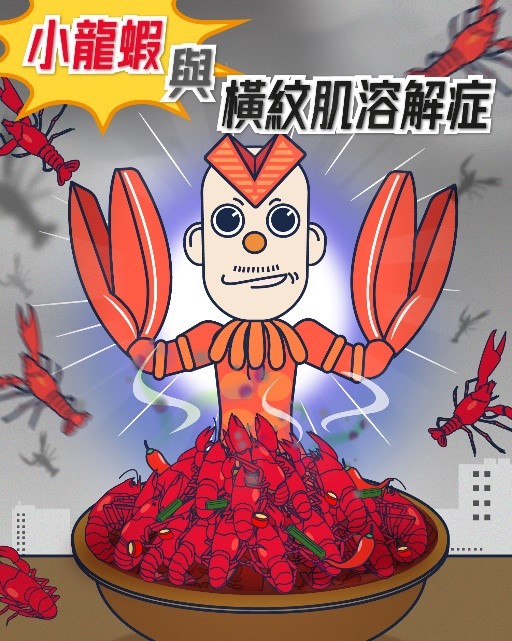
Feature Article
Fight Against Antimicrobial Resistance in Ready-to-eat Food
In recent decades, antimicrobial resistance (AMR) microorganisms, also called “superbugs”, have become a looming threat to public health. These resistant microorganisms can spread through food due to misuse of antibiotics in humans and animals. AMR has caused concern as it makes infection treatment and death prevention more difficult. This prompts the need for action to improve food safety and coordination of action in respect of food, humans and the environment.
Ready-to-eat foods and AMR
Foods that have been prepared for consumption without any additional cooking are called “ready-to-eat” foods. Baked bread, pasteurised milk and canned products are considered ready-to-eat as they have been heated to a certain temperature to kill bacteria and can be consumed safely with or without further heat treatment.
However, some ready-to-eat foods are eaten in raw or undercooked state, such as sashimi, salad greens and undercooked meat. They are intrinsically high-risk as there is no or inadequate heat treatment to eliminate the microorganisms present that may pose risks to human health. The consumption of raw or undercooked ready-to-eat foods is also associated with the risk of contracting “superbugs”. “Superbugs” are microorganisms that have developed AMR to stop a wide range of antimicrobial agents (e.g. antibiotics) from working against them, making infection treatment even harder.
How does AMR Spread to Humans
AMR occurs naturally over time, usually through genetic changes. It can also be a result of antimicrobial misuse. Humans may contract AMR bacteria via contaminated food source. Faeces on farms, if not treated properly, may cause contamination, which enables resistant bacteria to enter the food chain through the soil or water source contaminated by faeces. Morever, the use of contaminated water for irrigation may spread resistant bacteria to fruits and other produce. How animals are slaughtered at markets and transported are also critical in that if some of the food is turned into ready-to-eat foods for consumption, AMR bacteria may enter the food chain.
In the local context, the Pilot Survey on AMR Microorganisms in Food in Hong Kong conducted by the Centre for Food Safety (CFS) between 2019 and 2020 revealed that 15.1% of the ready-to-eat food samples collected were detected with “superbugs”. The findings should act as a reminder to people of the risk of contracting “superbugs”, among other bacteria that cause food poisoning, from ready-to-eat foods. Currently, the CFS is conducting AMR surveillance in food, including ready-to-eat foods such as sashimi and salads.
How to Tackle the Problem of AMR in Ready-to-eat Foods
Thorough cooking before consumption is the most effective way to kill “superbugs” that may be present in food. Consumers should however be aware of the potential risk of contracting “superbugs” when eating certain raw and undercooked ready-to-eat foods. Susceptible populations such as pregnant women, infants and young children, the elderly and immunocompromised people (including people with chronic diseases or on antibiotics treatment, antacids, long-term steroids or anti-rejection drugs) are of higher risk and should avoid eating raw or undercooked ready-to-eat foods.
When preparing ready-to-eat foods, follow good food hygiene practices, including:
- Keeping ready-to-eat foods completely separated from raw foods (e.g. meat and poultry) and using separate utensils for preparing ready-to-eat foods;
- Washing produce thoroughly under running water to remove dirt and minimise bacteria on them. This, however, does not guarantee removal of all disease-causing microorganisms and “superbugs”;
- Washing hands thoroughly before and after handling food; and
- Making sure work surfaces and utensils (e.g. chopping boards and knives) are clean and disinfected before and after use.
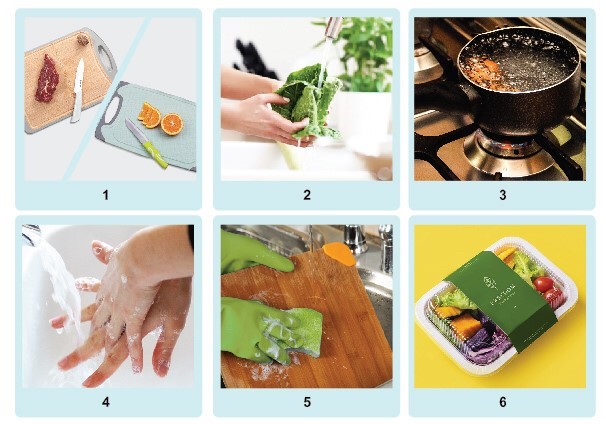
Useful ways for dealing with “superbugs” in food
Mascot ON in Lesson
Ciguatera Fish Poisoning
The Centre for Health Protection (CHP) has in the past investigated two suspected ciguatera fish poisoning (CFP) outbreaks affecting a total of 10 persons. They developed symptoms of CFP after consuming tiger grouper, a type of coral reef fish. None of them required hospitalisation. This article seeks to examine what CFP is, its effects and prevention.

Gambierdiscus toxicus can produce ciguatoxins (photo taken by Dr. Maria A. Faust, Department of Botany, National Museum of Natural History, Smithsonian Institution, Washington D.C., U.S.A.)
What are Ciguatera Fish Poisoning and Ciguatoxins?
CFP was first recorded as early as 1511 in the West Indies. CFP is endemic in many waters, including tropical and subtropical Pacific, where many of the live coral reef fish sold in Hong Kong are sourced. It is caused by the consumption of coral reef fish that contain ciguatoxins. The toxins accumulate up the food chain which starts with the herbivorous fish that graze on toxic marine planktons in the coral reef and accumulate successively in the body of larger carnivorous fish.
Ciguatoxins are a group of heat-stable, fat-soluble compounds. They are produced by marine plankton Gambierdiscus toxicus. The plankton live in the waters between latitudes 32°N and 32°S whereas ciguatera fish are confined to the waters near this area. The toxins are 50 to 100 times more concentrated in the viscera, liver and gonads than other parts of the affected fish, while the fish itself remain asymptomatic. As ciguatoxins are heat-stable and cannot be removed by cooking or processing, the nerve and muscle functions of the persons who consume ciguatera fish may be affected. CFP has become a common type of marine food poisoning worldwide due to the flourishing international seafood trade.
Effects on Humans
The symptoms can appear as quickly as 30 minutes, though a delay of 24 to 48 hours after consumption of CFP fish is more common. The initial symptoms are gastrointestinal or neurological in nature. Gastrointestinal symptoms such as vomiting, diarrhoea, nausea and abdominal pain usually last only a few days, while neurological symptoms such as tingling of lips, hands and feet, skin itching, change in temperature perception, fatigue, muscle and joint pain appear later and last longer, sometimes up to a few years. In severe cases, low blood pressure, slow heart rate, respiratory difficulties and paralysis are possible, but death is uncommon.
Other factors like previous CFP intoxication, as well as consumption of alcoholic beverages and nut and seed products can also trigger CFP intoxication more easily.
Local Situation
Upon receipt of notifications of CFP cases, the CFS will investigate the premises and suppliers concerned in order to identify the species and source of the implicated fish. Investigations and surveillance are difficult because food remnants are often unavailable. In addition, traceability records are incomplete as registration and record-keeping by the trade at present is entirely voluntary. According to the records of the CHP, there were 32 confirmed cases of CFP between 2007 and 2009, affecting 102 persons. The CFS’s investigations showed that of all the fish implicated in CFP, the most common species were squaretail coral grouper, lyretail, brown marbled (tiger) grouper and leopard coral grouper; other species involved were orange spotted grouper, humphead wrasse, two-spot red snapper and moray eel, etc. The CFS’s investigations with the trade also suggested that the most frequently contaminated fishing grounds were Nansha Island, Kiribati and Hainan Island, and that the size of the fish involved usually ranged from 0.6 to 3 kg (1 to 5 catties), although fish outside this weight range had also been reported. The above information on the species and sources of fish may be biased as it cannot be verified.
Upon the enactment of the Food Safety Bill, food traders are required to keep relevant transaction records (acquisition records, supply records or capture records as appropriate). Therefore, it is envisaged that the data collected in the future will be able to provide more accurate information on fish species and their sources.
Dining Out
Enjoying Barbecue Safely and Healthily
The re-opening of barbecue pits makes it more convenient to have barbecues. Before we fire up the grill, there are a few points to note for prepping food safely. When the food is heated to a temperature of over 200°C, hazardous chemicals, such as polycyclic aromatic hydrocarbons, may be formed with the decomposition of fat. In addition, we should always stay vigilant against food poisoning caused by undercooked food and cross-contamination of cooked food by raw food.
To reduce the formation of hazardous chemicals when barbequing, avoid direct contact of food with the flame and dripping of fat into the heat source. While not overcooking the food, we must cook it thoroughly to kill foodborne pathogens. Do not consume charred food and the charred parts of the food should be removed. To prevent cross-contamination, use separate utensils to handle raw and cooked food and maintain hand hygiene. Develop a healthy eating habit by eating plenty of fruits and vegetables.
Healthy Eating Basics and Smart Food Choices
Healthy Eating Basics
Is Ornamental Fish Meant for Consumption?
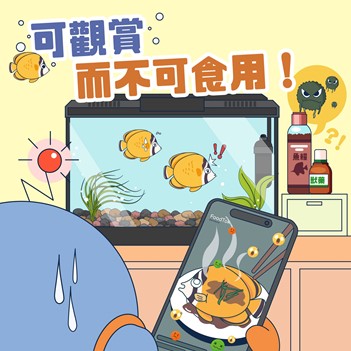
An online discussion about eating ornamental fish has aroused public concerns about food safety. Fish for consumption and most fish that people keep as pets are different in species and how they are raised. Though some fish species may be used for both ornamental and consumption purposes, consumers may not be able to distinguish the edible species.
Ornamental fish is not raised to be food. As these fish may not be fed with pathogen-free feed, they may be contaminated with parasites and bacteria. Some medications for treating ornamental fish diseases should not be used in fish for consumption. For example, certain veterinary drugs (e.g. malachite green) and antibiotic residues (e.g. chloramphenicol) are harmful to humans. Some of these chemicals are heat-stable and cannot be removed by cooking. Moreover, some fish (such as dog-faced puffer fish) contain life-threatening toxins.
Ornamental fish is not meant for consumption. Consumers should only buy edible fish from licensed food premises. Food businesses must ensure that the fish they sell are fit for human consumption and are in compliance with local laws.
Smart Food Choices
Nordic Light Meal –Sole Fillet Toast
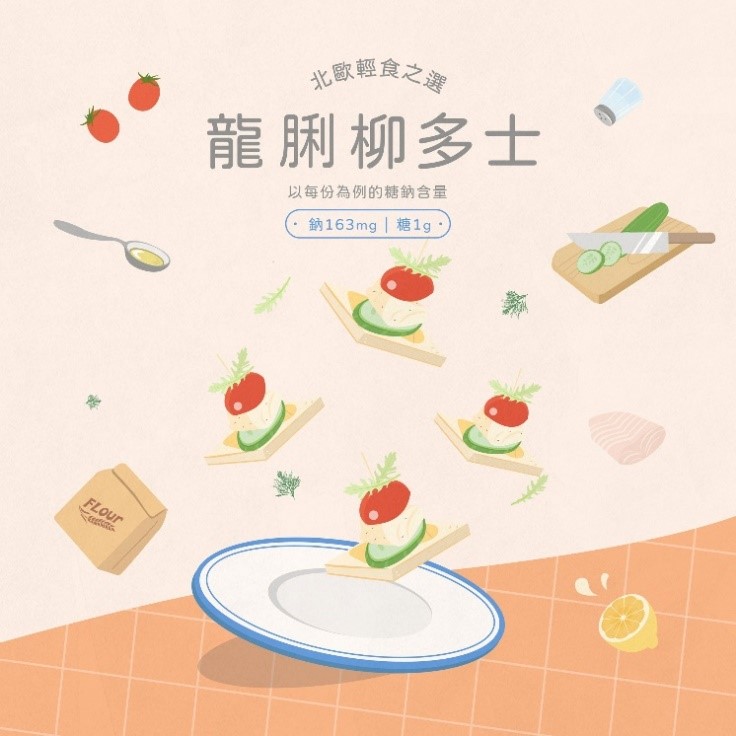
Sometimes when you have poor appetite, do you prefer a light meal but don’t want to make do with a salad? In this issue, Jimmy Coffee will recommend to you a nutritionally balanced dish “Sole Fillet Toast”, which contains seafood, vegetables and carbohydrates. It is definitely a healthy and refreshing choice.
Sole fillet is rich in protein while low in fat. Using mixed herbs to marinate the sole fillet can reduce the use of salt and the intake of sodium, which helps to maintain a desirable blood pressure level. This is a very simple dish that you can make with your kids. Please visit the following website for the Eat Smart Recipe: https://restaurant.eatsmart.gov.hk/eng/content.aspx?content_id=1040

News on CFS
1. Regular Talks on the Daya Bay Contingency Plan
The CFS has been jointly organising regular talks on the Daya Bay Contingency Plan with relevant government departments (including the Department of Health, the Electrical and Mechanical Services Department and the Food and Environmental Hygiene Department). The latest talk was held on 2 December 2022. Departmental representatives took turns to share on topics relating to their scope of work, such as nuclear power generation, radiation monitoring, radiation exposure pathways, surveillance of imported food, management of contaminants and wastes, radiation devices, and protective equipment monitoring, so as to keep our colleagues abreast of the information about the contingency plan.
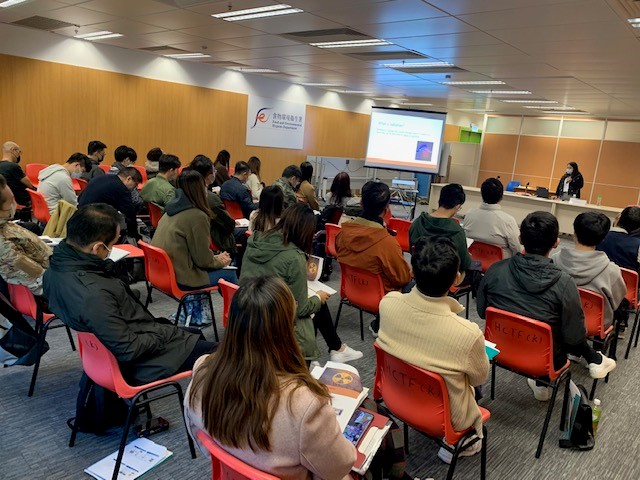
2. The 56th Hong Kong Brands and Products Expo – Distribution of Limited-Edition “Food Safety Lucky Bags by CFS”
The annual Hong Kong Brands and Products Expo is one of the major outdoor trade fairs in Hong Kong. The 56th Expo was held at Victoria Park in December 2022. Same as previous years, the CFS joined the Expo to disseminate food safety messages to the public. For two consecutive days on 29 and 30 December 2022, the CFS set up a booth in the Expo to give out exquisite “Food Safety Lucky Bags” containing a reusable canvas bag with the words “Be smart Eat smart”, a pair of plush toys of our mascots, On and Mui, a 2023 desktop calendar, a timer, a towel and a magnet board. The booth was bustling with visitors. In addition, the CFS staff distributed publicity leaflets, pamphlets and souvenirs to the visitors to promote food safety on the spot.

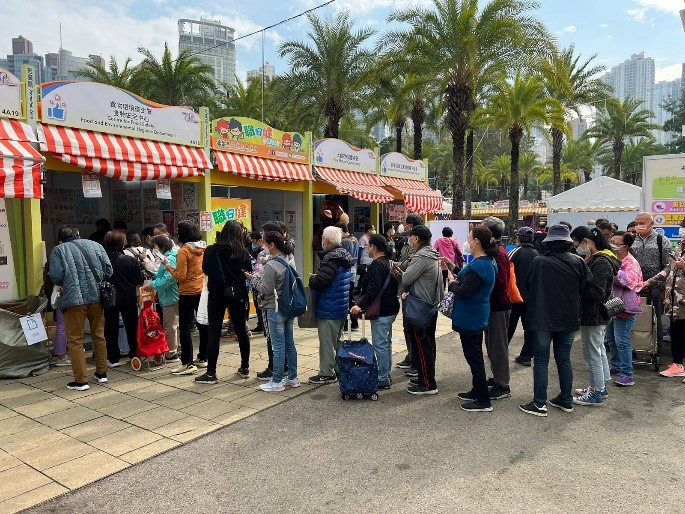
3. Distribution of 2023 Calendars by CFS
The CFS has recently gave exquisite calendars printed with food safety messages to members of the Consumer Liaison Group (CLG) as gifts in appreciation of their continued support.
[+photo]
You are welcome to join the CLG and receive these souvenirs. The application form can be downloaded from the CFS’s website (https://www.cfs.gov.hk/clg).

Ask Our Mascots
Dispelling Food Safety Myths – Colour Seepage in Purple Sweet Potato
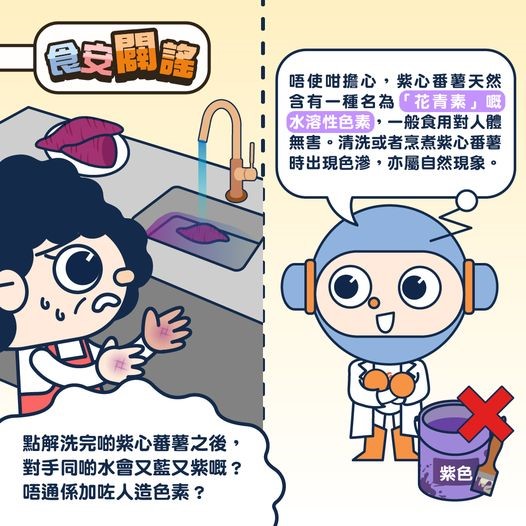
Mrs TAM: Recently, I’ve seen some gorgeous purple sweet potatoes at the market, so I bought some home. Who would have thought that after washing them, both my hands and the water turned bluish purple? Could this mean that… artificial colour has been added?
ON: No worries! In fact, purple sweet potatoes contain a naturally occurring and water-soluble colour called anthocyanin, which is commonly found in a lot of fruits and vegetables, such as grapes, purple cabbages and berries, and is generally innocuous for human consumption. In general, it is a natural phenomenon that when fruits and vegetables are washed or cooked, colours naturally present in them (e.g. anthocyanins in purple sweet potatoes and purple cabbages; lycopenes in tomatoes; and carotenes in carrots) will exude.
MUI: But of course, you should take note of the following key points to avoid any pitfalls when buying food such as fruits and vegetables:
- Purchase food from reliable shops and do not patronise unlicensed on-street hawkers;
- Avoid as far as possible food with abnormally intense colour and sold at an excessively low price;
- When cooking, check if the food colour remains abnormally intense; and
- Do not buy or consume any food when in doubt.
For more information: https://bit.ly/3yjEIV7

Food Safety Quiz
- Disease-causing microorganisms grow rapidly in food when takeaways and delivered meals are kept within the Temperature Danger Zone for a prolonged period. What is the range of the Temperature Danger Zone?
- What is the minimum temperature (°C) at which hot food should be kept throughout the process from preparation to delivery?
- What disease may arise from the consumption of red swamp crayfish or freshwater fish?
Answers:
- 4°C to 60°C
- 60°C
- Rhabdomyolysis
Diary of Mascot ON
The Battle Against Red Swamp Crayfish
Mr TAM (Crayfish Alien): I am going to conquer the earth today with my Crayfish army!
ON: MUI, in the past, there were global cases of Rhabdomyolysis after the consumption of red swamp crayfish or freshwater fish. The possible cause is an unknown heat-stable toxin that accumulated in the crayfish or freshwater fish. Symptoms of Rhabdomyolysis include muscle breakdown, muscle weakness, muscle pain, muscle rigidity, dark brown urine and kidney damage.
MUI: ON, to combat these crayfish, we should take note of the following:
❗️Purchase or consume red swamp crayfish from reputable and reliable shops;
❗️Do not consume red swamp crayfish from unknown sources or catch wild red swamp crayfish;
❗️Clean red swamp crayfish before cooking and cook thoroughly;
❗️Do not overindulge in red swamp crayfish;
❗️Do not consume the heads and internal organs of red swamp crayfish; and
❗️If you have generalised or localised muscle pain after eating red swamp crayfish, you should seek medical treatment immediately and tell the doctor about your food consumption history.
For further investigation: https://bit.ly/3B8NF59
